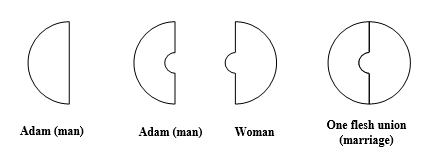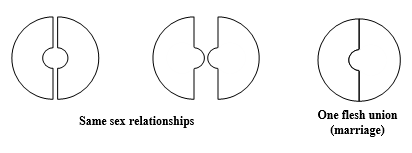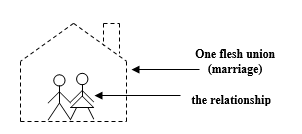Resources
9 July 2023
6:30pm
What marriage is and what it's for
Let’s pray as we stand:
Father, Thank you for your plan from beginning to end, which we’ve just sung. And thank you for giving Jesus to die and rise again, to bring us back to you and to living within your plan. Please show us more of how to do that as men and women. In Jesus’ name, Amen.
Please have a seat. Well, last week, we started a series called ‘Jesus on men and women’. Because with all the messages we’re getting about sexuality, gender and relationships, we need to be convinced of God’s message, and some of us will still be working out whether we are. So we’re unpacking Jesus’ fullest teaching on this area of life, so that he sets the agenda of what we need to hear. And I realise it will remind us of our struggles and failures in this area, as well as our sadnesses and hurts, like unwanted singleness, or unhappy marriage; or divorce; or unwanted feelings for the same sex, or finding we can’t have children; or the shadow of having been abused. To name only some. So, as I said last week, I’ll be treading as carefully as I can. But if I don’t get that right, or don’t get things clear, then please catch me sometime, or join us for the question and discussion time afterwards, or drop me an email – ian.garrett@church.org.uk
So would you open the Bibles to page 824 and Matthew 19, where, as I said last week, the translators have put in the heading ‘Teaching about divorce’.
Which isn’t a good one, because although Jesus’ teaching here was prompted by a question about divorce, it’s about far more. So, last week we saw that it’s about how we’re created but fallen. So we’re created male and female, as bodily, sexual beings – which is good, but we’re also fallen – so that some of our desires and feelings are not good, and not be lived out. And this week, we’ll see that it’s about: ‘What marriage is and what it’s for’. So would you look down to Matthew 19.3:
And Pharisees came up to [Jesus] and tested him by asking, “Is it lawful to divorce one's wife for any cause?”
So they taught that a man could divorce his wife simply because she no longer pleased him, and that he then had the right to re-marry. So they were really asking ‘Is it OK to end one marriage and go on to another when you feel like it?’ Which sounds very contemporary, doesn’t it? Because one strong message we hear today is: ‘Look inside yourself, and let your own feelings tell you how to live.’ So that people who leave their marriages because they feel like it are now more likely to be applauded for being true to their feelings, than criticised for being false to their promises and their partner. And Jesus basically said to these Pharisees: ‘That question shows you don’t understand what marriage is and what it’s for. So let me tell you…’ (Matthew 19.4-5):
He answered, “Have you not read that he who created them from the beginning made them male and female [where he’s quoting Genesis 1], and said, ‘Therefore a man shall leave his father and his mother and hold fast to his wife, and the two shall become one flesh’? [where he’s quoting Genesis 2].” So they are no longer two but one flesh. What therefore God has joined together, let not man separate.”
And my first point sums that up. Jesus says there that:
1. Marriage is a lifelong, one flesh union between a man and a woman
Just follow through Matthew 19.4-6 with me again to see exactly what Jesus is saying. He answered, Have you not read that he who created them from the beginning made them male and female… In other words, God created them in a particular way, male and female, different. Read on, Matthew 19.5:
and [he] said, ‘Therefore…
In other words, because of the way I’ve created them different, something can happen. And, read on, the something is that:
a man shall leave his father and his mother and hold fast to his wife, and the two shall become one flesh’?
So the way God has created men and women means that when a man and a woman come together in marriage, God creates a one-flesh union. I was at a wedding last weekend, where Tom and Bethan both did something. They both dressed up – Bethan looked wonderful; Tom looked… unrecognisable. They both smiled for 12 hours non-stop. And most importantly, they both said, ‘I will’ to each other. But God also did something. In every marriage, God creates a one-flesh union to give a man and a woman a secure structure within which they can live out their relationship for the rest of their lives. And like last week, Jesus takes us back to creation to see that that’s what marriage is. So would you turn back in the Bibles to page 2 and Genesis 2. Last week, we looked at what Jesus quoted from Genesis 1. And Genesis 1 and 2 give two complementary accounts of creation – two views of the same thing. And as Liz Jackson put it in the discussion time last week, Genesis 1 is like satellite view in Google maps; it gives the high-level picture of the creation of the whole universe, where mankind does appear, but not in great detail. Whereas Genesis 2 is like street view, where we jump down into the Garden of Eden to see Adam and Eve, the first human pair, up close. Only with suitable computer blurring, because at this stage they’re not wearing any clothes. So the bit of Genesis 1 we looked at last week in satellite view gets expanded in Genesis 2 in street view. So look down to Genesis 2.18.
The LORD has already created Adam, the man. Then the Lord God said, “It is not good that the man should be alone; I will make him a helper fit for him.”
The footnote says, ‘or corresponding to him’. Literally the original says ‘a helper like and opposite him.’ It’s the idea of different but complementary – like adjoining jigsaw puzzle pieces. And don’t be nervous about that word helper; in the Old Testament it’s applied to God more than anyone, as the helper of his people. So no inferiority is implied. What happens next? Well, as we read earlier, Adam meets and names the animals. So something rubs his ankles and he says ‘You’re a cat.’ Something else jumps up and licks his face and he says ‘You’re a labrador.’ And they make great pets, but they’re not the partner he needs. So end of Matthew 19.20-24:
But for Adam there was not found a helper fit for him. So the Lord God caused a deep sleep to fall upon the man, and while he slept took one of his ribs and closed up its place with flesh. And the rib that the Lord God had taken from the man he made into a woman and brought her to the man. Then the man said, “This at last is bone of my bones and flesh of my flesh; she shall be called Woman, because she was taken out of Man.” Therefore a man shall leave his father and his mother and hold fast to his wife, and they shall become one flesh.
So look at this:

There on the left is Adam, and the picture in Genesis 2 is that God created the woman from Adam in such a way that they’re different but complementary, so that when they come together in marriage, God creates a unique, one flesh union – which can only happen between a man and a woman.

So, next picture, it can’t happen between a man and a man or a woman and a woman. That doesn’t mean people in same sex relationships can’t love and care for and be committed to one another – they can and do. But it does mean they can’t form this unique, one flesh union one thing it’s unique for is the potential for having children. Now sadly, in a fallen world, some married couples find they can’t have children. And of course many children are born outside marriage. And of course fertility technology and adoption can bring about the artificial reality of children given to same sex couples. But that doesn’t change the point that the one flesh union of marriage between a man and a woman is the only created reality designed to bring children into the world. It’s unique for that. It’s also unique for providing children with the context their nurture needs – of their biological father and mother, with the complementary love and role models that they need. Although, sadly, in a fallen world that’s never perfect and sometimes lost.
I’d also want to say how it’s unique in other ways, as a relationship compared to all other relationships, but there isn’t time. So heterosexual marriage, as we now have to clarify it, is unique. Whereas same sex marriage is something very different. And introducing it has re-defined marriage in our culture. So it used to be understood as a loving relationship between a man and a woman which includes sexual consummation and the potential to have children. Whereas now it’s just understood as an emotional and loving bond between people, which is far less than Jesus says it is. So that’s point 1, as Jesus takes us back again to creation reality: Marriage is a life-long, one-flesh union between a man and a woman Point 2 is this:
2. The one flesh union is created by God doing something, as the man and woman do something, as they get married
Look down again to Genesis 2.24 – which is the foundational verse in the Bible about marriage, which is why Jesus takes us back to it in his teaching:
Therefore a man shall leave his father and his mother and hold fast to his wife, and they shall become one flesh.
So what do a man and woman do as they get married? Well for one thing, they both leave their own families to create a new family – a new building block of society. And that’s why marriage is done publically and legally. It’s because the couples’ families, and wider society have a stake in it working. So promises are made publically, so that the couple can be held lovingly accountable to them – but also so that they can be supported in keeping them. Then next in verse 24, the man holds fast to his wife – and she reciprocates. The original word means ‘sticks permanently’. So this is the promise-making, covenant-making part of marriage. Which is why the question we ask in the wedding service is not, ‘Do you love him or her?’ (Which is generally fairly obvious). But, ‘Will you? In fact ‘Will you love her, comfort her, honour and protect her, and forsaking all others, be faithful to her as long as you both shall live?’ Because attraction and chemistry can draw a man and a woman together, but they won’t keep them together. For that you need promised commitment. Now of course God also means there to be attraction and chemistry. You see that in the Old Testament book Song of Songs, where the young Romeo says to his love (Song of Songs 4.1):
Your hair is like a flock of goats leaping down the slopes of Gilead
Tuck that one away for next time your wife’s back from the hairdressers. Or how about (Song of Songs 4.2):
Your teeth are like a flock of shorn ewes that have come up from the washing
Remember, this was before toothpaste. So chemistry and attraction draw people together, and then in the secure structure of the one flesh union they can grow even more. But it’s the promised commitment, enabled by God, which holds people together. And then lastly in Matthew 19.5, they become one flesh, which includes their sexual union, but it means their total union of lives – still two individuals, but with a union of wills, of hearts, of God-given purpose – and of course of bodies. And the union of bodies has three purposes. One is having babies (God-willing), which we’ve already mentioned as part of the uniqueness of the one flesh union of marriage; and which we’ve already said may sadly not be possible for some married couples. But if children do come, God means them to have the albeit imperfect context of the one flesh union of marriage to grow in.
Another purpose of sex is bonding the relationship. I fixed something a while back with Superglue, and realised in the process I’d stuck my thumb and forefinger together. And the packet said ‘seek hospital attention’. But clearly I couldn’t drive (although I remember thinking ‘I could cycle’). And in the end I just pulled them apart – which, needless to say, hurt. And having sexual union and then pulling apart also hurts. Because one purpose of sex is to create and deepen a permanent bond between a man and a woman. So it’s not just recreational. It’s not even just relational Bluetac – to be used as long as a relationship lasts. It’s relational Superglue. And then the other purpose of sex is is that it’s the body language of married love. So we use body language all the time, don’t we? So a hand-shake says ‘Friendly but formal’. A hug says you’re good mates, or brother and sister – or Tellytubbies. So what’s sex saying? According to the Bible, it’s a way of saying ‘I give myself to you totally, permanently, exclusively, uniquely.’ One Christian writer says this:
To be naked with another person is symbolic of perfect honesty, perfect trust, perfect giving and commitment, and if the heart is not naked along with the body, then the whole action becomes a lie… the giving of the body but the withholding of the self.Exposure of the body is like the telling of one’s deepest secrets… And it is in effect the very last step in human relations…. It is not a step which creates deep intimacy, but which presupposes it.[The Mystery of Marriage, Mike Mason]
And those three purposes of sex are why God says in his Word, for our good, that sex is for the one flesh union of marriage only. So that, according to Genesis 2.24, is what a man and a woman do as they get married. Let’s turn back now to page 824 and Matthew 19 to see what Jesus says God does. Matthew 19.6, Jesus says:
So [because of all we’ve seen in Genesis 2] they are no longer two but one flesh. What therefore God has joined together, let not man separate.
So, like I said, at the wedding I was at last weekend, it wasn’t just Tom and Bethan doing something. God was doing something too. Because the way God has created men and women means that when they come together in marriage he actually creates something that’s more than their relationship. He creates this one-flesh union, to give them a secure structure within which they can live out their relationship for the rest of their lives. Through all the ups and downs of changes: changes in feelings, changes in attraction, changes in health, changes in age, changes in interests, changes in circumstances, changes in children joining the nest and flying it, you name it.

You can’t see it with the physical eye, but the one flesh union is a real, creation structure. And God designed it to be like an invisible ‘safe house’ within which a relationship can be lived out, and problems worked through. Which explains why Dietrich Bonhoeffer wrote to his neice on the eve of her wedding and said:
It is not your love which will sustain your marriage, but your marriage which will sustain your love.
And, as we’ll think about more next week, the one flesh union is a lifelong reality. It’s designed to sustain the relationship ‘as long as you both shall live’, like the wedding service says. And it remains a reality even if the relationship breaks down. Well as we’ve unpacked Jesus’ teaching here on marriage, he hasn’t just told us what marriage is but also what it’s for.
So we’ve mentioned that it’s for having and nurturing children, God-willing.
Which means it’s not a haven from work and responsibility. We’ve mentioned that it’s for sustaining a lifelong and sexual relationship. But that’s not to be inward-looking and for the two of us. It’s meant to be outward looking, to use our marriage to serve God’s purposes. And we’ve mentioned that it’s for creating a new building block of society. So that we look out to serve our wider families, our neighbourhoods, our schools, and so on. But the highest purpose of marriage in the Bible is to act as a picture of the relationship between God and his people, between Jesus and his church.
